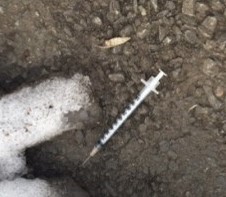A child finds a needle in the park. He accidentally sticks himself with it. This entails a trip to the ED and great worry from his family but fortunately no permanent harm comes from the episode.
What do we do about the problem of used syringes left in public places?
There is an interesting article Needs-based or needless? A 2,327% spike in unreturned IV drug needles, on the website Inside investigator.
A local real estate developer has made a cause of what claims to be an increasing number of syringes he and the people he has paid to help him document the situation have found in his New Haven neighborhood. He points the finger at a change the state made in their syringe services program several years ago. Previously a person could only receive one new syringe for every old syringe they returned. The change enabled people to receive more syringes with the goal that every time someone used a syringe it would be a clean needle. This would further help prevent the spread of disease through shared needles as well as help avoid infections. While this change clearly helps get closer to the goal of no shared needles, it decreases the incentive for people to pick up discarded syringes so they can exchange them for new ones to either use themselves or sell for a $1 a syringe, which was the rate a few years back.
The investigative story details both the developer’s claims and the responses of long-standing researchers and harm reduction advocates.
I remember talking to my friend Kelly and hearing her tell me how only receiving syringes on a one for one exchange was difficult and how she and her friends often had to rescue or share needles until they could get to the exchange to get fresh ones. It also meant carrying used loose syringes in her backpack. I told her I would mention this at the statewide meetings I attended. Unbeknownst to me the state was already planning to switch and when they did the next week, Kelly believed that I was the one who made the change. I told her it was not so.
Over the years I have walked through the areas where users often shoot up outside. While I still find syringes on a regular basis, I can’t say I noticed a huge increase in the syringes post the policy change. Not scientific study, just anecdote. I do think in the last couple years fewer people are using drugs than they used to, and I think more people are inhaling or smoking as opposed to injecting, but again, all just speculation.
What is the solution to the problem of syringe litter? I don’t think cutting back on the number of syringes allowed is the right approach. Keeping the spread of disease down and limiting infections is important. I think funds should be available for groups to regularly sweep these areas. Perhaps we also install needle collection boxes in high-risk areas. I have seen such boxes in a port-o-potty or two. (An interesting point made in the story is many of the syringes are from insulin injections used by homeless people with diabetes.) We should also approve overdose prevention centers where people can inject in safe indoor spaces under the eyes of people who can give them naloxone if they overdose, provide them with clean syringes and talk with them about getting the services they need, everything from housing to treatment. This will help keep people alive and help keep the neighborhoods freer of syringes and drug paraphernalia.

